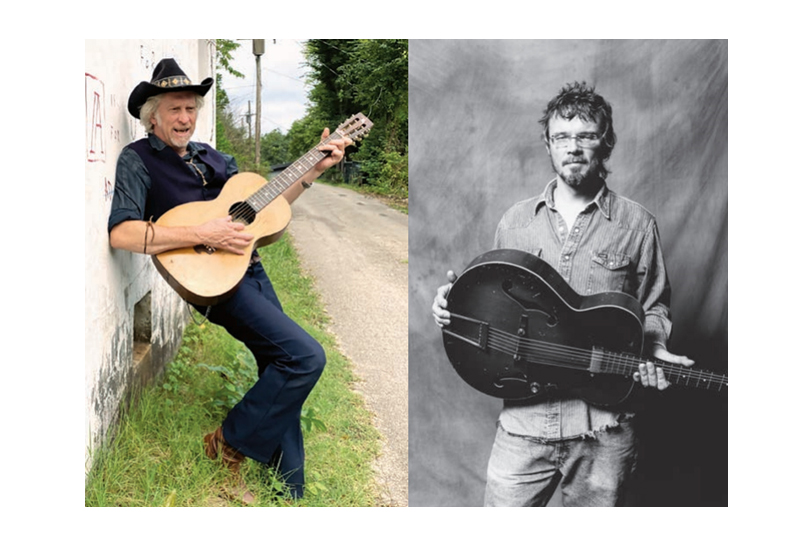Spotlight: The New Moon Jelly Roll Freedom Rockers

In 2007, brothers Luther and Cody Dickinson were on tour with Mavis Staples and Charlie Musselwhite. Their group, the North Mississippi Allstars, was ostensibly hired to be the house band for the run, but the brothers ended up walking away with an entirely different project, The New Jelly Roll Freedom Rockers.
“We were all riding on the same bus,” Luther Dickinson explains of the all-star combo, who released their self-titled record in September and plan to drop another volume in 2021. “Charlie and I were hanging out and talking. We had a lot of good material worked up—we had a really good rapport. I love instigating projects, so, of course, I said, ‘Let’s record!’”
Musselwhite was game, so Luther started scheduling a session at his family’s Zebra Ranch Recording Studio in Coldwater, Miss. He was surprised to find that the harmonica legend had never met his father, Jim Dickinson. “I was like, ‘You’ve got to get together with my dad,’” Luther recalls. “I was surprised that they hadn’t been friends since they were teenagers. They hit it off instantly.”
In addition to Jim and Cody, Luther enlisted Alvin Youngblood Hart and The Squirrel Nut Zippers frontman Jimbo Mathus to round out the project’s personnel. “Alvin Hart and I have a long history with the Zebra Ranch Studio,” Mathus notes. “We were both part of the family. I remember, at the time, just being excited, humbled and honored to be a part of a session like that with all my good friends.”
Given that level of comfort, it isn’t surprising that Luther describes the experience as “a party.” However, the Dickinsons’ recording sessions have historically had a festive flair. Responding to a statement in a press release that “the Dickinson crew doesn’t enjoy parties but we dig recording sessions,” Luther says. “Hell, to be honest, [for] my bachelor party, we just stayed at my friend’s house and recorded. Recording sessions are my favorite thing to do.”
The songs featured on The New Moon Jelly Roll Freedom Rockers—or at least volume one—are a mix of traditional blues cuts such as “Come on Down to My House,” covers like Jimi Hendrix’s “Stone Free,” and originals, including a raucous, lengthy take on Musselwhite’s “Strange Land.”
The tracklist was, unsurprisingly, improvised. “We’d just go around the room and say, ‘OK, Jim, you do one,’ or ‘OK, Charlie, you do one,’ etc.,” Mathus recalls with a chuckle. “They’d just call out a tune—we might not even talk about the key. We just said, ‘Let’s work together.’”
The musicians were not tethered to their primary instruments either. “That’s what’s so fun, too—you switch up instruments,” Luther observes. “I might say, ‘Oh, I’ll play mandolin or I’ll play bass or let’s do three guitars.’ It’s really fun to fill the different holes.”
Mathus and Luther agree that they were only able to reach that level of spontaneity because all the players were so in sync, both musically and personally.
“In my favorite type of bands, the music is a byproduct of the friendships,” Luther says. “I like making records when it’s really just a bunch of friends getting together, playing and hanging out.”
“We all have the same studio philosophy,” Mathus adds. “So it was basically just a jam session. We got together with the tape rolling.”
Luther notes he intentionally tried to avoid blues reference points, specifically in relation to Musselwhite’s powerful harmonica playing. “Charlie’s an old-school psychedelic warrior—he moved to San Francisco at the height of the scene,” he explains. “So I like bringing that side of him out, as opposed to just being a hardcore-blues guy.”
“Luther’s approach to the blues has always been toward the psychedelic,” Mathus adds. “[Luther and Cody] are known for that psychedelic edge with the Allstars, for sure, and with Jim growing up in the heyday of the ‘60s, it has always there, ready to be turned loose.”
While the sessions clearly left each musician feeling fulfilled, there wasn’t much thought about turning the tracks into an album at the time. “We tried to shop it back in the day, but not aggressively. We really weren’t trying to make a record, much less two records,” Luther says.
The set ended up sitting on the shelf for years, during which time Jim passed away in 2009. Luther credits Stony Plain Records founder Holger Petersen for setting the actual release in motion. “We owe all that to Stony Plain and Holger,” he says. “Charlie mentioned it to him and he was like, ‘Oh, my god, I love this!’” (The album also took on additional meaning when it turned out to be one of the last LPs that Jim Dickinson would end up playing on.)
Mathus is quick to commend Luther’s commitment to their self-titled debut, both in terms of its creation and its ultimate release. “Luther has a way of creating projects like this and also seeing them to fruition,” he says. “He has a long-term vision of things. I believe he always knew it would come out and that’s just the kind of dude he is. He’s very inclusive and always tinkering and experimenting. He loves the studio as much as we all do, especially in a situation like this. There was an importance and gravitas to it at that time.”
However, Luther simply believes it was all meant to be.
“I just threw a great party, bringing all these great musicians together,” he says. “There was a communal energy.”




















